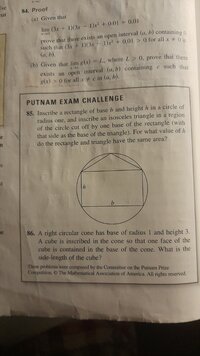You are using an out of date browser. It may not display this or other websites correctly.
You should upgrade or use an alternative browser.
You should upgrade or use an alternative browser.
it confused me
- Thread starter James1019
- Start date
- Joined
- Feb 4, 2004
- Messages
- 16,583
The question is asking you to use the picture and the given variables to create expressions for the areas of each of the rectangle and the triangle. Then set those expressions equal, and solve for the value of the specified variable, h.what does it means For what value of h do the rectangle and triangle have the same area, it confused me.
What is the question trying to ask?
Not a native English speaker.
I suspect that you are expected to assume that the triangle is isosceles.
Possibly a good way to start would be to draw a diagonal in the rectangle, and see if you can solve for b in terms of h.
Eliz.
Steven G
Elite Member
- Joined
- Dec 30, 2014
- Messages
- 14,383
Maybe this will be clearer for you.
The area of the rectangle depends on h.
The area of the triangle also depends on h.
That is, if you change h, both the area of the triangle and the area of the rectangle will (probably) change.
You are being asked to find the exact for h where the area of the rectangle = area of the triangle.
The area of the rectangle depends on h.
The area of the triangle also depends on h.
That is, if you change h, both the area of the triangle and the area of the rectangle will (probably) change.
You are being asked to find the exact for h where the area of the rectangle = area of the triangle.
The Highlander
Full Member
- Joined
- Feb 18, 2022
- Messages
- 937
All the advice given above is sound but there is one small (potential) problem to be sure you avoid...what does it means For what value of h do the rectangle and triangle have the same area, it confused me.
What is the question trying to ask?
Not a native English speaker.
The triangle is explicitly stated to be isosceles, so no worries on that score, but...I suspect that you are expected to assume that the triangle is isosceles.
The usual formula for the area of a triangle is: ½ × base × height (or ½bh)
and for (this) rectangle: base × height (or bh)
However, in this case, the height of the triangle will not be the same as the height of the rectangle when their areas are the same!
Therefore, you must avoid using "h" in both of these formulae or you will end up with the nonsensical result: ½b = b (or ½ = 1)
Since "b" & "h" are already 'allocated' to the rectangle, I would suggest you re-write(?) the formula for the triangle's area as: ½bT where T (or Th if you prefer) is the height of the triangle.
One final hint: your answer should simply be an integer multiple of "h"
- Joined
- Feb 4, 2004
- Messages
- 16,583
D'oh! ?The triangle is explicitly stated to be isosceles, so no worries on that score, but...

